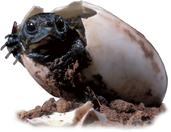25.2 Animal Body Plans and Evolution
 What are some features of animal body plans?
What are some features of animal body plans? How are animal phyla defined?
How are animal phyla defined?
radial symmetry • bilateral symmetry • endoderm • mesoderm • ectoderm • coelom • pseudocoelom • zygote • blastula • protostome • deuterostome • cephalization
Concept Map Draw a concept map showing the different features of animal body plans and the different types of each feature.
THINK ABOUT IT Animals alive today have typically been produced by two processes: the development of a multicellular individual from a single fertilized egg cell, and the evolution of a modern species from its ancestors over many millions of years. The history of the evolutionary changes to animal body structures has been known for years. Today, exciting research is revealing how changes in the genes that control embryological development are connected to the evolution of body structures. This research field, often referred to as “evo-devo,” is one of the hottest areas in biology today.

Features of Body Plans
 What are some features of animal body plans?
What are some features of animal body plans?
Our survey of the animal kingdom focuses on how animal body structures and systems perform life's essential functions. Each animal phylum has a unique organization of particular body structures that is often referred to as a body plan.  Features of animal body plans include levels of organization, body symmetry, differentiation of germ layers, formation of body cavities, patterns of embryological development, segmentation, cephalization, and limb formation.
Features of animal body plans include levels of organization, body symmetry, differentiation of germ layers, formation of body cavities, patterns of embryological development, segmentation, cephalization, and limb formation.
Levels of Organization As the first cells of most animals develop, they differentiate into specialized cells that are organized into tissues. Recall that a tissue is a group of cells that perform a similar function. Animals typically have several types of tissues, including epithelial, muscle, connective, and nervous tissues. Epithelial tissues cover body surfaces, inside and out. The epithelial cells that line lung surfaces, for example, have thin, flat structures through which gases can diffuse easily.
Tissues combine during growth and development to form organs. Organs work together to make up organ systems that carry out complex functions. Your digestive system, for example, includes tissues and organs such as your lips, mouth, stomach, intestines, and anus.

Table of Contents
- Formulas and Equations
- Applying Formulas and Equations
- Mean, Median, and Mode
- Estimation
- Using Measurements in Calculations
- Effects of Measurement Errors
- Accuracy
- Precision
- Comparing Accuracy and Precision
- Significant Figures
- Calculating With Significant Figures
- Scientific Notation
- Calculating With Scientific Notation
- Dimensional Analysis
- Applying Dimensional Analysis




